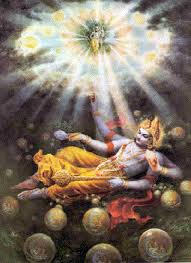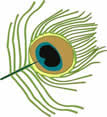Essence Of Maha Bhagavatha Purana |
|
 |
Suka MuniÆs prophecies about future Manus Maha Muni Suka prophesied the prospective Manu Prajapatis to King Parikshith as follows: While the seventh Manu was Siddhadeva, son of Vivasvan was in rule, the Great Battle of Devas and Danavas took place and Lord Vamana was born as an incarnation of Lord Vishnu. But, when the eighth Manu, Savarni commenced the rule of the Universe, King Bali became Indra, as he defeated the earlier Indra and consequently Lord Vamana asked for the three feet in charity and pushed Bali down to Sutala which was more opulent than Indraloka, as Lord Vishnu was pleased with Bali’s great quality of charity and thus made the latter contented. |
The ninth, tenth, eleventh, twelfth, thirteenth and fourteenth Manus would respectively be Daksha-Savarni, Brahma- Savarni, Dharma Savarni, Rudra-Savarni, Deva-Savarni and Indra-Savarni respectively.Suka Maha Muni also prophesied that the respective Indras in the ninth to fourteenth Manvantaras would be Adhbhuta, Sambhu, Vaidhrata, Ratadhama, Divaspati and Suchi.The total duration of the fourteen Manvantaras is a cycle of one thousand Maha Yugas or one Kalpa and two Kalpas make a full day/night of Lord Brahma ie.8,640,000,000 human years!Indeed, several changes happened during Lord Brahma’s one day, comprising fourteen Manvantaras.During the Deva-Danava Battle, King Bali’s life ended but was revived by Danava Guru, Sukracharya,the son of illustrious Sage Bhrigu. In a battle with Indra, King Bali defeated Indra again and hence the need for Lord Vishnu to take the incarnation of Lord Vamana to push Bali down to ‘Sutala’ and relieve him of the position/ title of Indra. This story was given in detail by Suka Maha Muni to King Parikshith. After reviving King Bali’s life, Sukracharya and his disciple Brahmanas prompted King Bali to secure Spiritual Energies by way of performing a highly potent Sacrifice or ‘Yagna’, called Viswajit.Even as the most powerful Yagna, as conceived and perfected by Sukracharya was in progress, the Heavens received shock waves and shadows of nemesis seeking revenge against Indraloka took substantive shape. With each helping of ghee served into the Fire-pit, a celestial Chariot took shape with horses and paraphernalia including armoury, arrows and equipment required for a battle never scripted in the past. No doubt, the fight planned by King Bali was not of the magnitude of the Battle of Devas and Danavas- where the entire strengh of Evil on the one hand and Virtue on the other which participated in full force of Demons and of Gods and Goddesses including Lord Siva, Durga, Kartikeya and Supreme Lord Narayana Himself- but was only with the aim of dislodging Indra and Demi-Gods from the Heaven. Thus this was like a territorial war between Bali and Indra. At the same time, the fight was tough enough since Demi-Gods had celestial powers and armoury like Indra’s Thunderbolt and the sriking power of individual Demi-Gods, apart from the Nectar that they consumed assuring them of eternal life, if not of invincibility. As a result of the Yagna, powerful bows and arrows and other equipment of destruction known as ‘Mantrastras’ capable of attacking the counterpart arms of fight possessed by Agni (Fire-God), Varuna ( Rain God), Vayu ( Wind-God), Sun, Moon and various other planets were made available, and with the blessings of Sukracharya the battle ended with the clear defeat of Indra and his associate Demi- Gods. Thus entered Bali into the Heaven, when Indra and Demi-Gods were obliged to exit. Bali controlled Heaven, Earth and Antariksha besides the Sub- terrain world. As Bali and followers were gloating over their victory and occupying the ‘Titled- Chairs’ of Indra and other Demi-Gods, the erstwhile holders of the honours were at large without refuge.The spectacle became unbearable to the Mother figure of Devathas, Aditi, who beseeched her husband Sage Kasyapa.He advised her to perform Payo Vrata or Sarva Yajna during the bright fortnight of Phalguna (February-March) for twelve days ending ‘Dvadasi’subsisting only on milk, worshipping the Supreme Power Narayana with Arghya/ Padya/ flowers/ incense material/ lamp lighting and prasada and such other rituals, observe Karma Kanda, Jnana Kanda and Upasana Kanda, meditate Him as having Two heads ( Prayaniya and Udaniya), Three Legs (Savana Traya), Four Horns ( Four Vedas) and Seven ‘Chandas’ such as Gayatri Chanda, Anushtup Chanda, Usnik, Brihati, Pankti, Trishthup, Jagati, Atichhanda, Atyasthi, Atijagati, and Ativirath and other metered hymns. During the period, one should observe celibacy, sleep on floor, bathe thrice a day and so on. On the final three days ending ‘Purnami’, there would have to be oblations to Fire-God as per the instructions of Priests, organise ‘Samaradhana’ or sumptuous meals to one and all and satisfy the Brahmanas, especially the Spiritual Master ( Aharya) and his assistants like Hota, Udghata, Adharvu and Brahma. Most importantly, distribute Vishnu Prasad liberally to low class persons, the Poor, the invalids and animals. Sincere performance of the Sarva Yajna ought to yield far reaching results by regaining the lost glories and attaining fresh rewards. This was the essence of Sage Kasyapa’s advice to Aditi and her progeny. As advised the Demi Goddess Aditi performed the Vrata meticulously under the guidance and association of Sage Kasyapa and they were blessed by Narayana to take the incarnation of Lord Vishnu. |
|
| Maha Bhagavatha Purana Home |  |
Back to the News Page